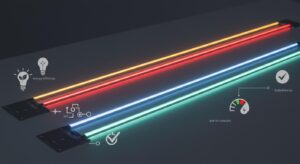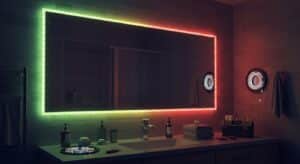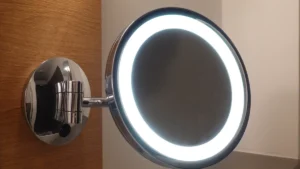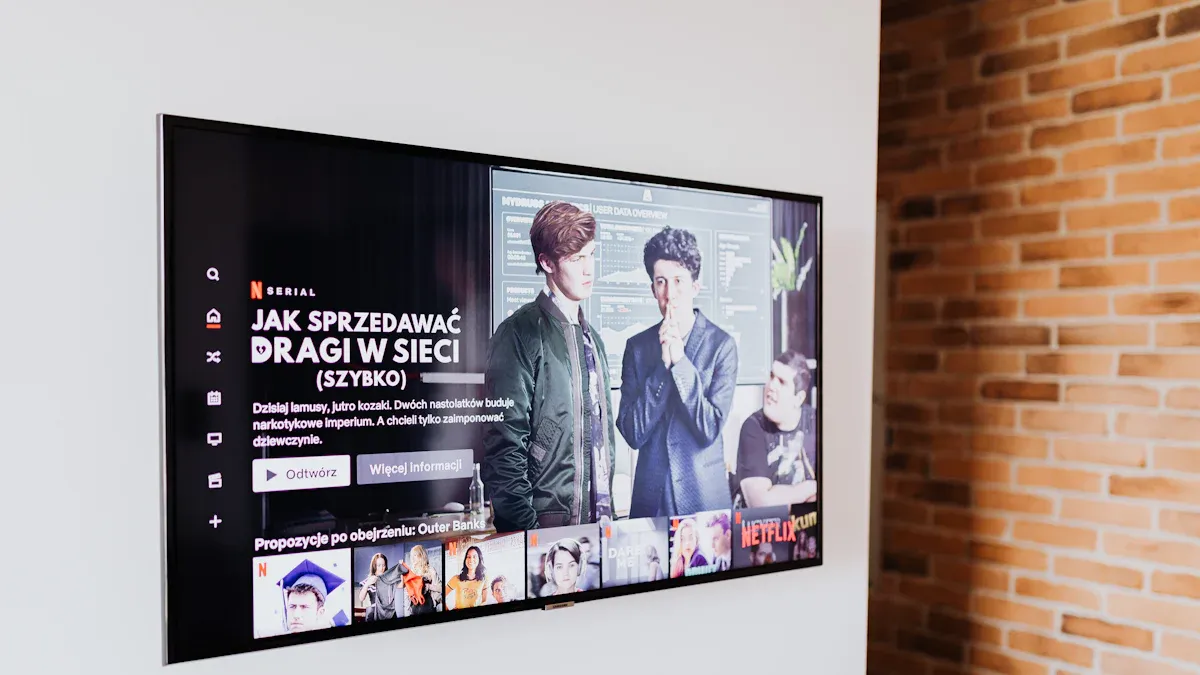
An LED module TV is a flat screen that uses tiny lights called LEDs as its pixels. This cool technology has changed how we see pictures on screens. It gives brighter images and better colors. Unlike older TVs, LED screens use less power, saving electricity. They also last longer, making them better for the environment.
More people around the world are using LED TVs. Samsung is the top brand with 19% of the market, followed by Hisense and TCL. Many huge TVs, from 90 to 115 inches, use LED technology. By 2024, the global TV market might reach $182 billion because LED TVs work so well.
Key Takeaways
LED module TVs use small LED lights for bright pictures. This makes the images clear and saves energy too.
These TVs last longer than older ones. You won’t need to fix or replace them often. They are a good choice for the long term.
LED module TVs are thin and light. You can hang them on walls easily. They fit well in modern homes without needing big furniture.
They use less energy than older TVs. This lowers your electricity bill and helps the environment by using less power.
With features like better colors and wide viewing angles, LED module TVs make watching fun for everyone in the room.
What is an LED Module TV?
What makes LED module TVs special?
An LED module TV is a flat screen that uses tiny lights called LEDs to show pictures. Older TVs used fluorescent lights, but LED TVs use these small LED lights for brightness. These lights are grouped into sections, working together to make clear and colorful images. Each dot on the screen has red, green, and blue lights. By mixing these colors, the TV shows millions of shades, making the picture look real and vibrant.
LED module TVs have special features like better color control and energy-saving technology. These features make the colors blend smoothly and use less electricity. They are also thin and light, so you can easily hang them on walls, saving space in your room.
How are LED module TVs different from other TVs?
LED module TVs are better than many other TVs because they last longer and work well. Some LED TVs, like edge-lit ones, have lights only on the edges. This can make them hotter and cause problems like cracks. But TVs with full-array or direct-lit LEDs spread heat evenly, avoiding damage over time.
Compared to older LCD TVs, LED TVs are brighter, use less power, and last longer. They are also cheaper and don’t have screen burn-in problems like OLED TVs. These benefits make LED module TVs a smart choice for homes and offices.
Where are LED module TVs used?
LED module TVs are used in many places. In churches, big LED screens make services more engaging. For example, a church in Indonesia uses a 45-square-meter LED screen to improve worship experiences. In control rooms, large LED screens help manage emergencies. A security office in Hubei uses a screen with super high resolution to handle crises better.
In offices, LED walls show off brands and fit modern designs. For instance, Dar Al Arkan’s Beijing office uses these screens to look professional and stylish. Stores also use LED displays to attract customers. A 68-square-meter 3D LED pillar in Beijing Joy City grabs attention with amazing visuals. Schools and hotels also use LED TVs to create fun and relaxing spaces, showing how useful they are in different industries.
Components of an LED Module TV
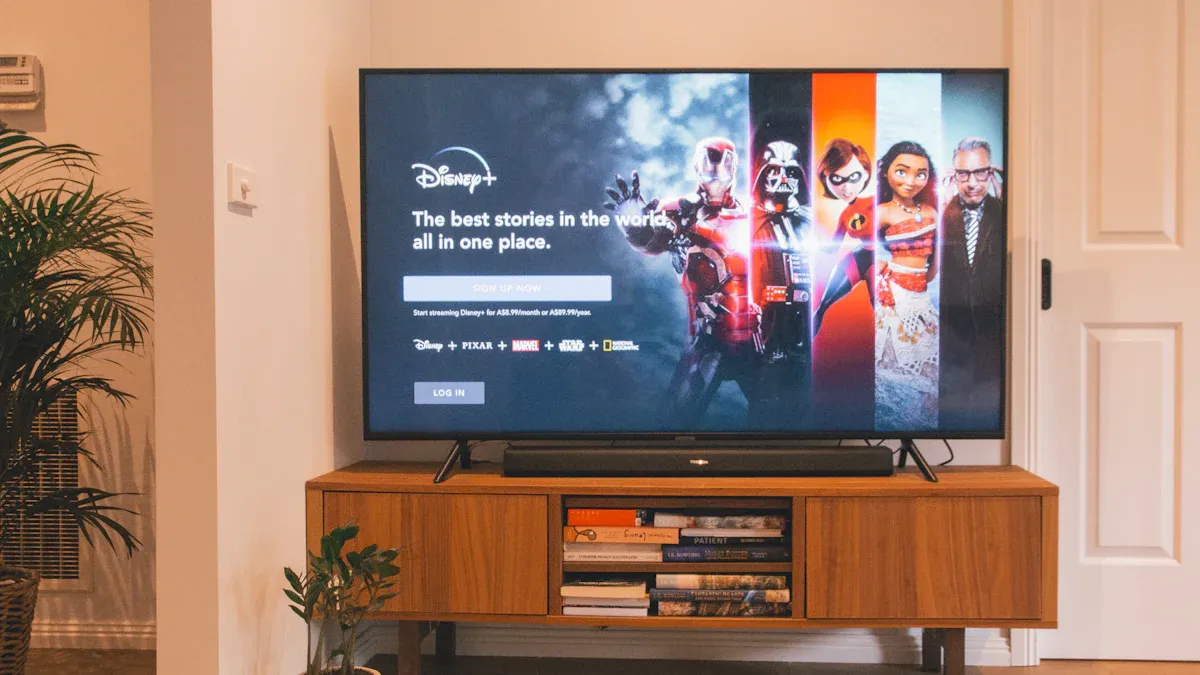
LED modules and their structure
The LED module is the main part of an LED TV. It has many parts that work together to show great pictures. These parts include tiny LED lights, a circuit board, chips, wires, connectors, resistors, screws, and capacitors. Each part helps the module work well. For example, the circuit board holds the LEDs, and the chips control electricity flow.
There are two main types of LED modules: DIP and SMD. DIP modules are very bright, so they are good for outdoor use. SMD modules handle heat better and are used indoors. Many LED modules are waterproof with an IP65 rating. This makes them strong and able to work in bad weather. This tough design helps LED TVs work well in many places.
Backlighting system in LED TVs
The backlight in an LED TV lights up the screen. It also makes the picture look better. Unlike old TVs, LED backlights use many small lights to spread light evenly. This makes the screen bright and clear from different angles. The backlight can also adjust brightness to improve colors and protect your eyes.
Here’s a table showing why LED backlighting is great:
Benefit | Description |
|---|---|
Long lifespan | LED TVs last longer, so you don’t replace them often. |
Excellent brightness uniformity | Light spreads evenly, so the screen looks clear from all sides. |
Flexible luminous frequency | No flickering, better colors, and less eye strain. |
Low voltage power supply | Uses less energy, saving power and helping the planet. |
This smart backlighting system is why LED TVs are so popular today.
Image processing and display panel
The display panel works with image technology to show sharp pictures. Modular LED screens are made of small LED modules. These let you change the pixel size. Smaller pixels make the picture clearer, which is great for close viewing. You can also create cool shapes like curved screens for different spaces.
The modular design is easy to fix. If one module breaks, you can replace it without fixing the whole screen. This keeps the TV working well and saves time. The high-resolution display makes watching more fun. This is why LED TVs are better than old LCD TVs or projectors.
How Does an LED TV Work?
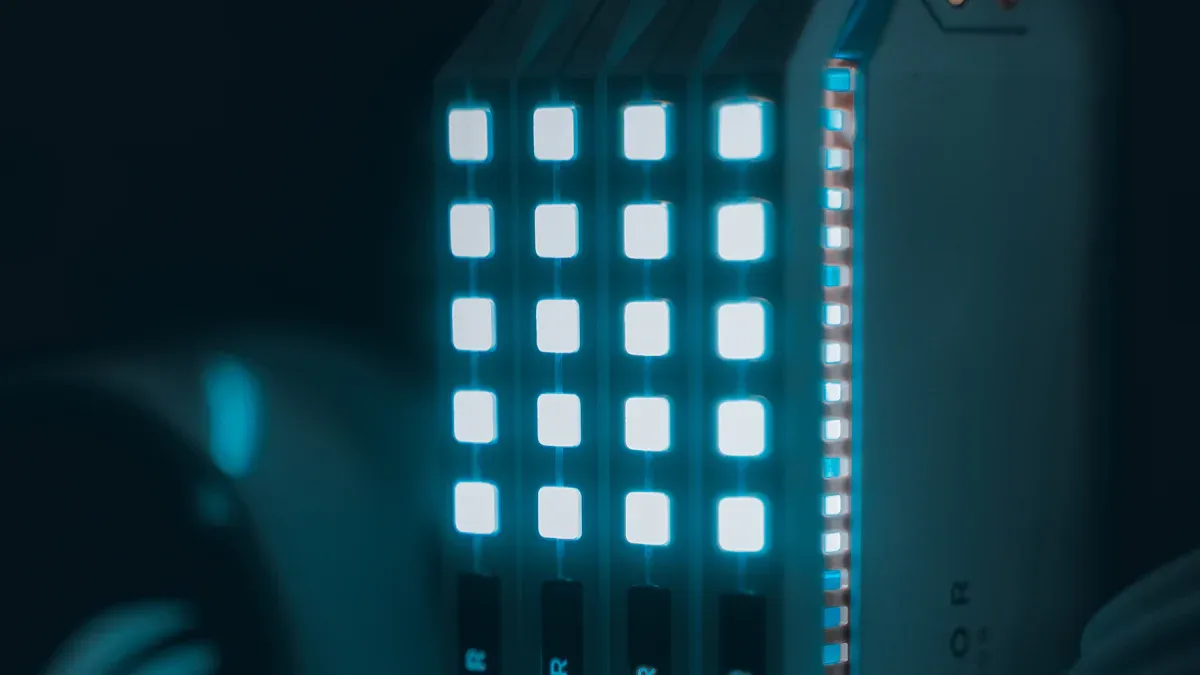
The role of LEDs in creating visuals
LEDs are key to how LED TVs work. They replace the big fluorescent tubes in older TVs. This makes the screen thinner and lighter. You can easily hang it on walls or fit it in small spaces. LEDs also allow features like local dimming. This means parts of the screen can change brightness separately. It improves contrast and makes black areas look darker, giving better picture quality.
Another cool feature is quantum dots. These tiny particles glow in colors when hit by blue LED light. They replace old color filters, making colors brighter and more accurate. RGB LED backlighting also helps. It uses red, green, and blue LEDs instead of white ones. This makes the screen colors look more real and vivid.
LEDs also save energy. Unlike fluorescent lights that stay on all the time, LEDs turn on and off quickly. This saves power and makes black areas on the screen look better. These features help LEDs create sharp images and great video quality.
Backlighting and light distribution
The backlight system in LED TVs makes pictures bright and clear. Light passes through layers of liquid crystals and color filters before reaching your eyes. This process creates sharp details and true colors. A strong blue LED powers the backlight. It works with red and green parts to make many colors while staying bright.
To spread light evenly, LED TVs use special parts. A light guide plate (LGP) spreads light across the screen. This stops dark spots and uneven brightness. The LGP is made of materials like acrylic and has tiny patterns to direct light. A diffuser film spreads the light more, reducing glare. Behind the LGP, a reflector film bounces light back to the screen, making it brighter without using extra energy.
Control electronics manage how LEDs work. They adjust brightness and power to save energy and keep the picture clear. This system gives LED TVs wide viewing angles and smooth, colorful images.
Color reproduction and brightness control
LED TVs show colors well by controlling brightness carefully. The Electro-Optical Transfer Function (EOTF) helps match brightness to the right colors. This makes the picture look more real and exciting. Wide Color Gamut Displays (WCGDs) in LED TVs show bright colors but can sometimes overdo it. To fix this, makers balance brightness and color depth for better picture quality.
Brightness control also affects how colors look on the screen. TVs adjust brightness in different areas to keep colors accurate. This is very important for high-resolution screens. Even small brightness changes can affect the picture. Studies show that our brain processes brightness and darkness separately. This proves how important brightness control is in LED TVs.
LED TVs use smart technology to handle brightness and colors. Gain control adjusts how bright background pixels are. Special neurons in the brain process black, white, and gray colors. These features make LED TVs show bright, lifelike colors with amazing picture quality.
Advantages of LED Module TVs
Energy efficiency and reduced power consumption
LED module TVs save energy and are great for homes or offices. Unlike older lights like incandescent or fluorescent ones, LEDs use less power but work better. They turn most of their energy into light, not heat.
Here’s a table comparing energy use and light efficiency:
Lighting Type | Energy Use (%) | Light Efficiency (%) |
|---|---|---|
Incandescent Bulbs | 100 | 10 |
Compact Fluorescent Bulbs | 45 | 45 |
LED Bulbs | 20 | 80 |
As shown, LEDs use only 20% of the energy of incandescent bulbs. They also give 80% light efficiency. This means lower electricity bills and less harm to the planet.
Enhanced brightness and contrast
LED module TVs are super bright and have great contrast. Contrast shows the difference between bright whites and dark blacks. Ratios like 1000:1 or 5000:1 make images look detailed and deep.
LED screens show bright colors, perfect for movies, games, or ads.
Their advanced backlights spread brightness evenly, removing dark spots.
These features make LED TVs clear, colorful, and better than older screens.
Durability and longer lifespan
Buying an LED module TV means getting something that lasts long. LEDs are tough and don’t wear out quickly like older lights. Fluorescent lights can flicker or stop working, but LEDs stay steady for years.
LED screens are modular, so if one part breaks, you can replace it. This keeps the TV working longer and lowers repair costs. With strong design and lasting performance, LED module TVs are a smart and durable choice.
Slim and lightweight design
A great thing about LED module TVs is their slim and light build. They use advanced LED technology, so they don’t need big parts like fluorescent tubes. This lets makers design thinner screens that fit well in modern spaces.
Mounting an LED TV on a wall is super easy. Its light weight puts less pressure on brackets, making setup safer and quicker. Whether it’s for your living room, bedroom, or office, the sleek look matches any style. Unlike old, heavy TVs, you won’t need big furniture or extra support to hold them.
Tip: Short on space? An LED module TV is a great pick. Its slim design saves room while giving you amazing picture quality.
Even though they’re thin, these TVs are strong. Makers use tough materials to keep them durable despite being lightweight. This mix of strength and portability is perfect for people who move often or like to change their room setup.
Here’s a simple comparison of TV thickness:
TV Type | Average Thickness (inches) |
|---|---|
CRT TVs | 15-20 |
LCD TVs | 4-6 |
LED Module TVs | 1-2 |
As shown, LED module TVs are much thinner than older TVs. Their light weight also makes them easier to set up or move around. With their stylish design and convenience, LED TVs are a great choice for modern homes.
Why Pick an LED Module TV?
Comparing LED TVs to LCD TVs
LED TVs are better than old LCD TVs in many ways. They use modern LED lights for backlighting, while LCD TVs use older fluorescent lights. This makes LED TVs use less energy and be kinder to the planet. They also show brighter pictures with better contrast, making colors pop.
LED TVs are thinner and lighter, so they’re easier to hang on walls or fit in small spaces. They last longer too. LCD TVs often have problems like uneven lighting, but LED TVs spread light evenly, avoiding these issues. To pick the best LED TV, think about these features for a great viewing experience.
Comparing LED TVs to OLED TVs
Both LED and OLED TVs have their own strengths. OLED TVs have pixels that light up on their own, giving true blacks and amazing contrast. But LED TVs are much brighter, reaching 5,000 to 8,000 nits, while OLED TVs only reach about 1,000 nits.
Here’s a simple comparison:
Feature | OLED TVs | LED TVs |
|---|---|---|
Light Emission | Pixels light up on their own | Needs LED backlights |
Brightness | Up to 1,000 nits | Up to 8,000 nits |
Price | More expensive | Cheaper and budget-friendly |
Power Use | Lower, black pixels turn off | Higher, backlights stay on |
If you want a bright and affordable TV, LED TVs are a great choice.
Why Choose LED Module TVs?
LED module TVs have many benefits that make them a top pick. They save energy, cutting down your electricity bills. They last longer, so you spend less on repairs or replacements. Their wide viewing angles are perfect for big groups, letting everyone see clearly.
Advantage | Description |
|---|---|
Energy Saving | Uses less power, saving money, especially for big setups. |
Long-Lasting | Built to last, needing fewer repairs and replacements. |
Wide Viewing Angles | Everyone can see clearly, even from the sides. |
Great Contrast | Shows deep blacks and bright whites for better picture quality. |
With these features, LED module TVs are a smart and reliable choice for homes and offices.
An LED module TV mixes smart tech with useful features. It uses LEDs to show clear pictures, bright colors, and saves energy. This makes it a great pick for modern screens. Whether for home, work, or public places, its slim build and toughness make it dependable.
Here’s why LED module TVs are a good choice:
Advantage | Description |
|---|---|
Uses Less Power | LED TVs need less energy than older types, saving money. |
Brighter and Clearer | They show sharp, colorful images in all kinds of settings. |
Lasts Longer | LED TVs work for many years, even with heavy use. |
Better Colors | They display more colors and make pictures look real. |
Eco-Friendly | Lower energy use helps the planet by cutting carbon output. |
If you want a TV that’s strong, efficient, and lasts long, an LED module TV is a smart pick. It gives great picture quality while being eco-friendly.
FAQ
1. Why do LED module TVs save energy?
LED module TVs use special lights called LEDs. These lights need less power than older ones like fluorescent bulbs. LEDs turn most energy into light, not heat. This lowers electricity use and saves money on bills.
2. Can you use LED module TVs outside?
Yes, some LED module TVs work outdoors. These TVs are made to handle bad weather. They often have waterproof designs, like an IP65 rating. Always check if the TV is made for outdoor use before buying.
3. How long can LED module TVs last?
LED module TVs last longer than older TVs. They can work for about 50,000 hours or more. How long they last depends on how you use and take care of them. This makes them a good choice for long-term use.
4. Are LED module TVs easier on your eyes?
Yes, LED module TVs are better for your eyes. They have features like brightness control, no flickering, and less glare. These features help reduce eye strain, even if you watch for a long time.
5. What sizes do LED module TVs come in?
LED module TVs come in many sizes. You can find small ones under 32 inches or big ones over 100 inches. Pick a size that fits your room or space, whether it’s small or large.
See Also
Understanding Cob Led Strips And Their Functionality
The Impact Of LED Modules On Signage Illumination
Selecting The Perfect LED Light Module For Your Needs
Exploring Backlight LED Bars And Their Operation
Installing LED Module Lights For Channel Letter Signage
